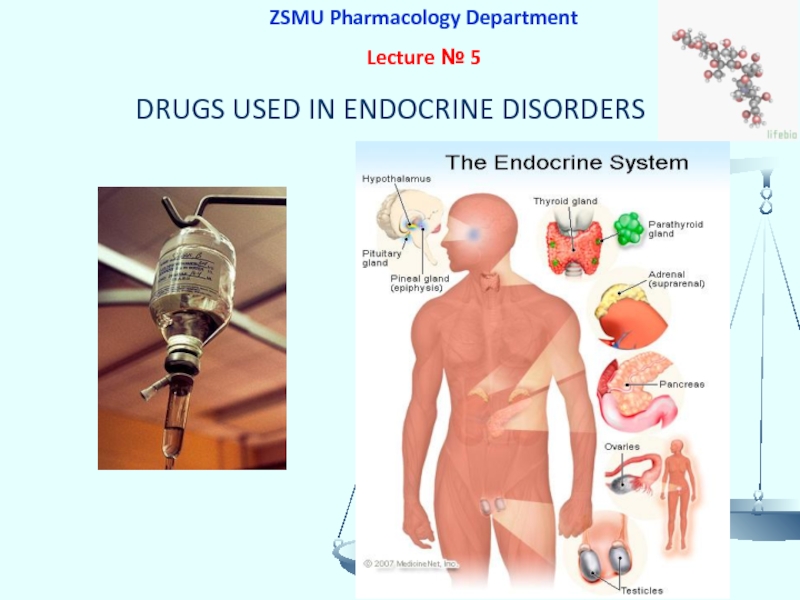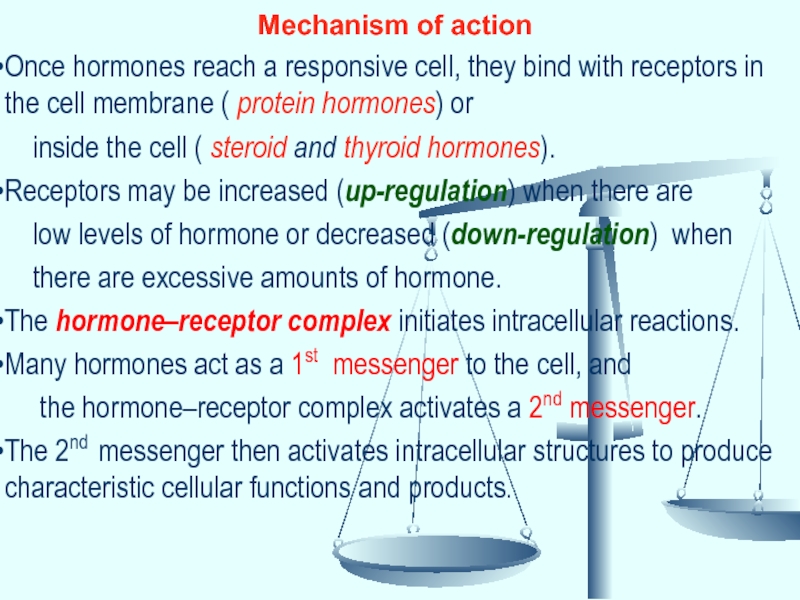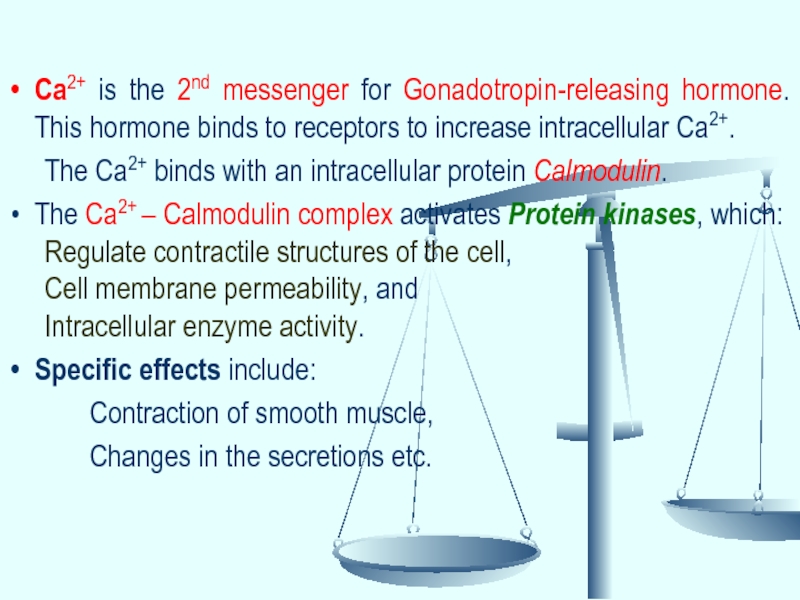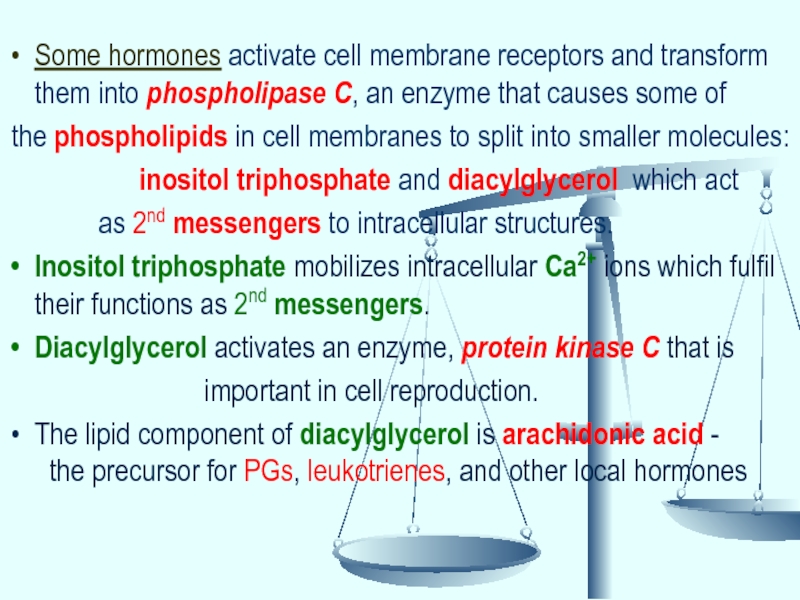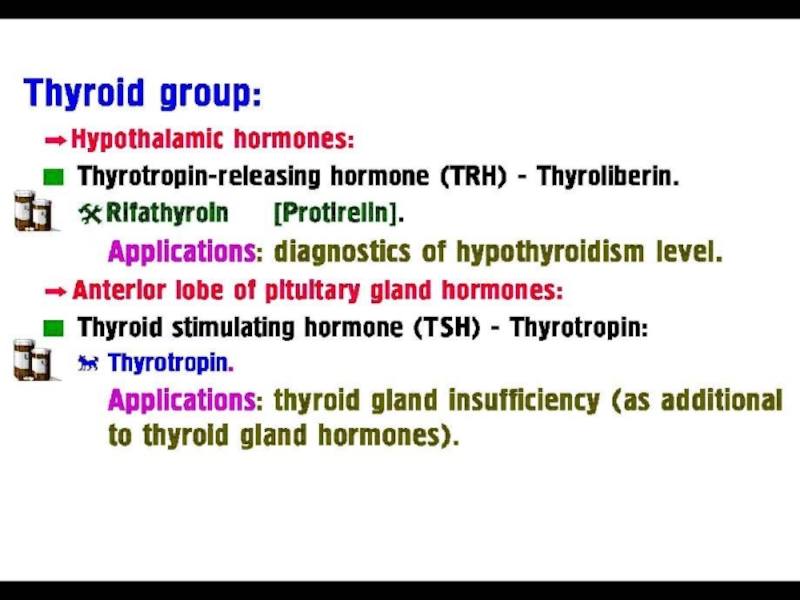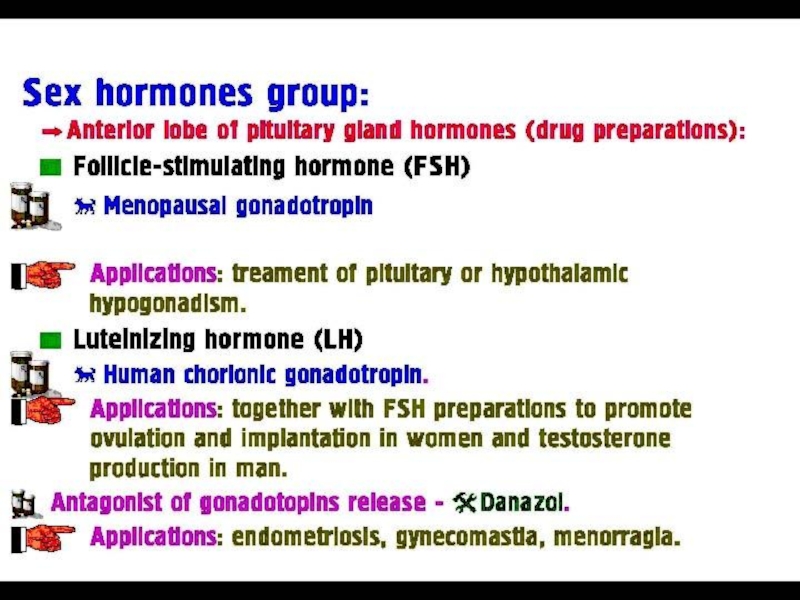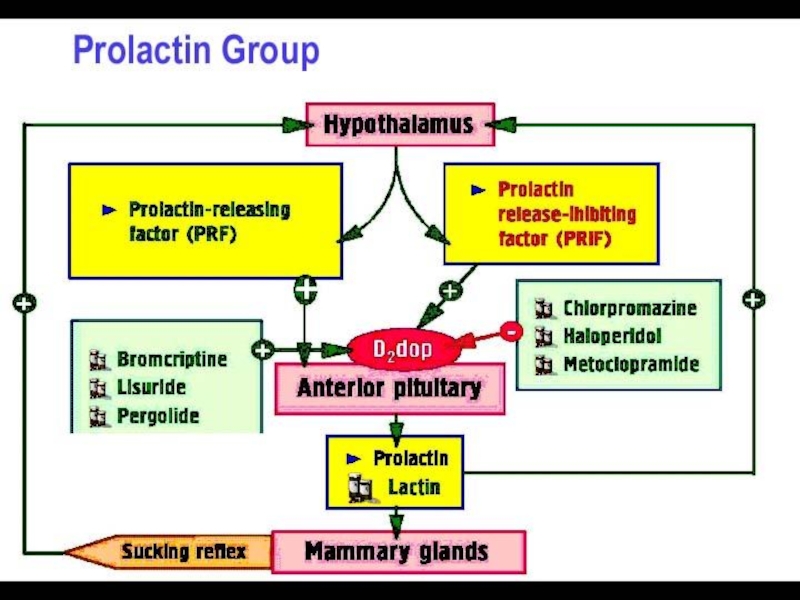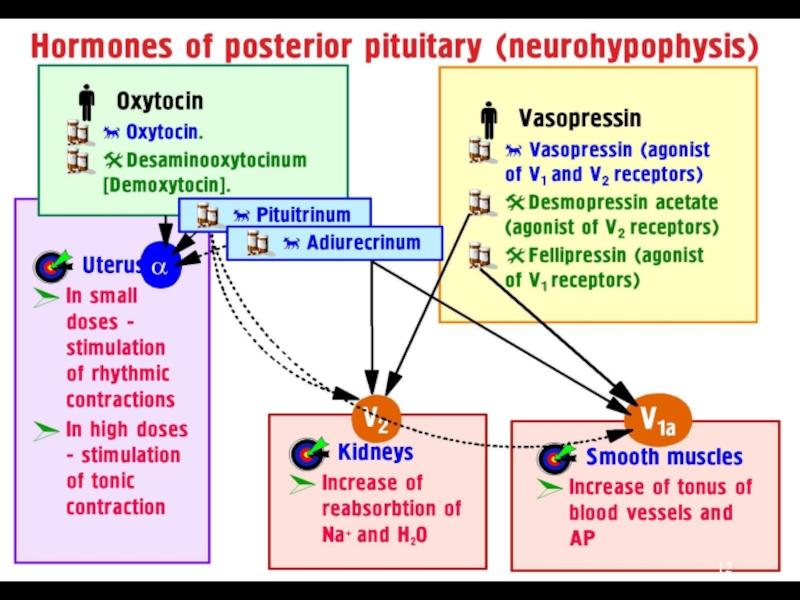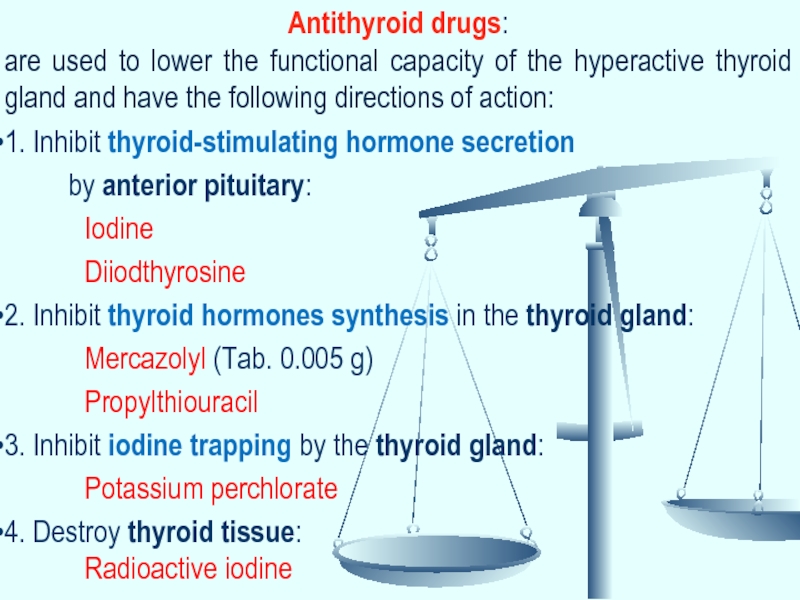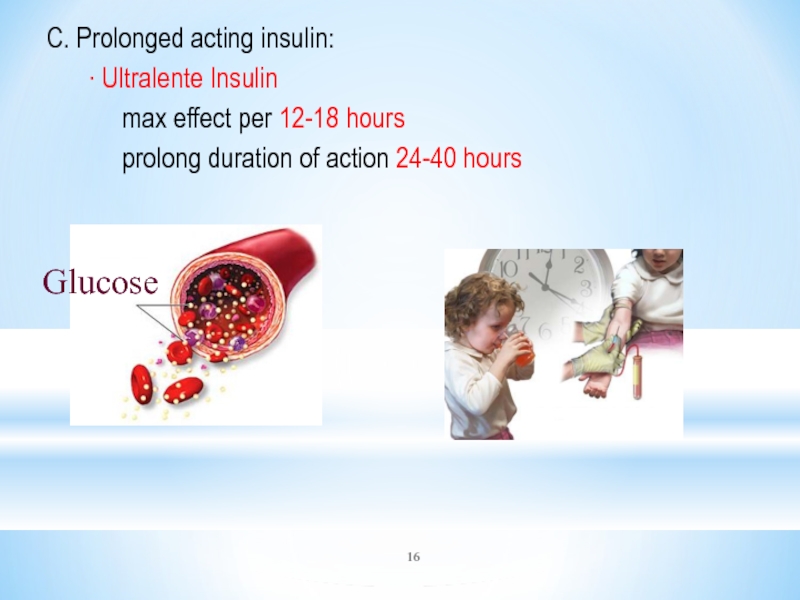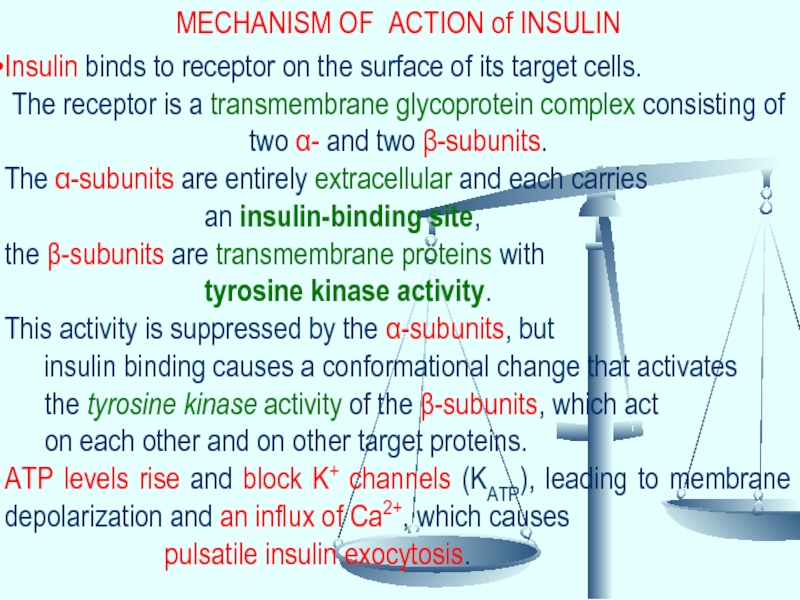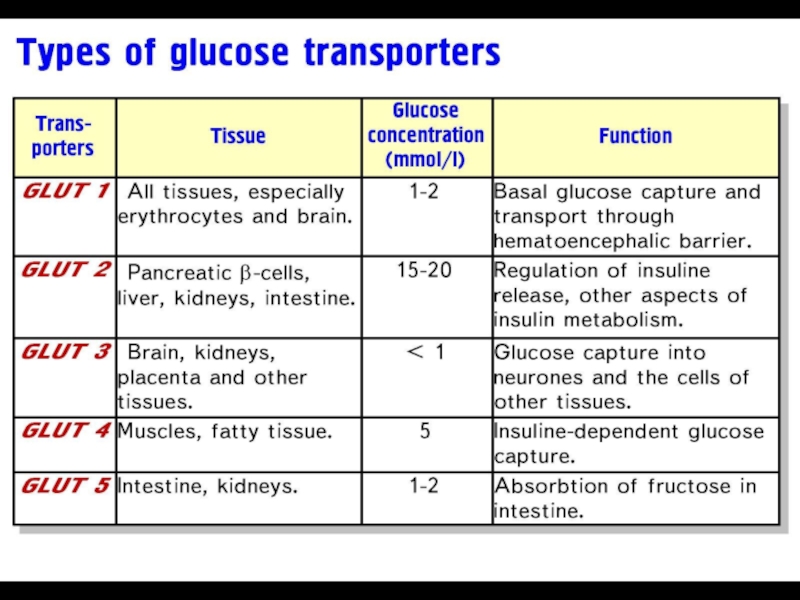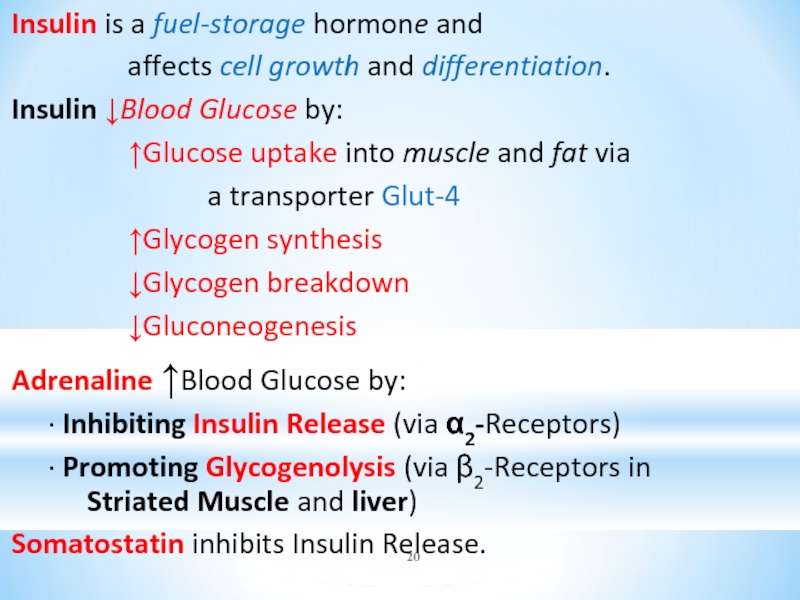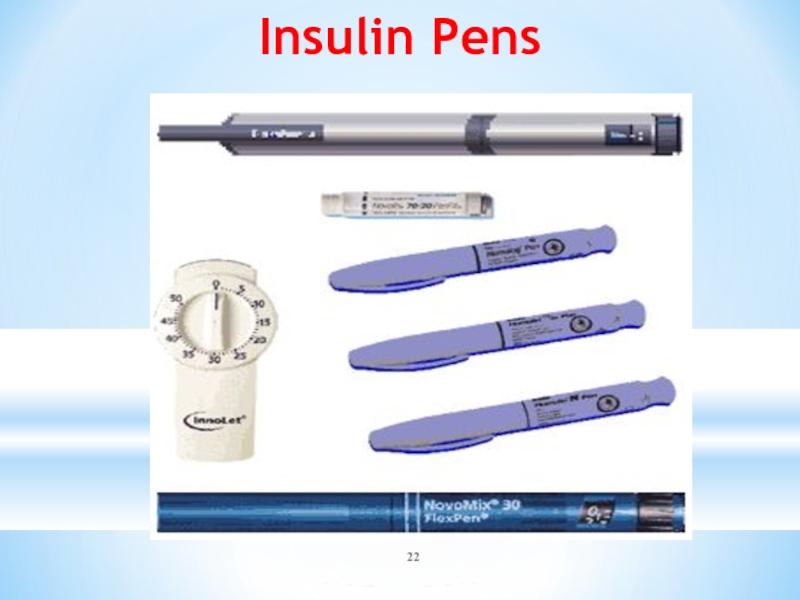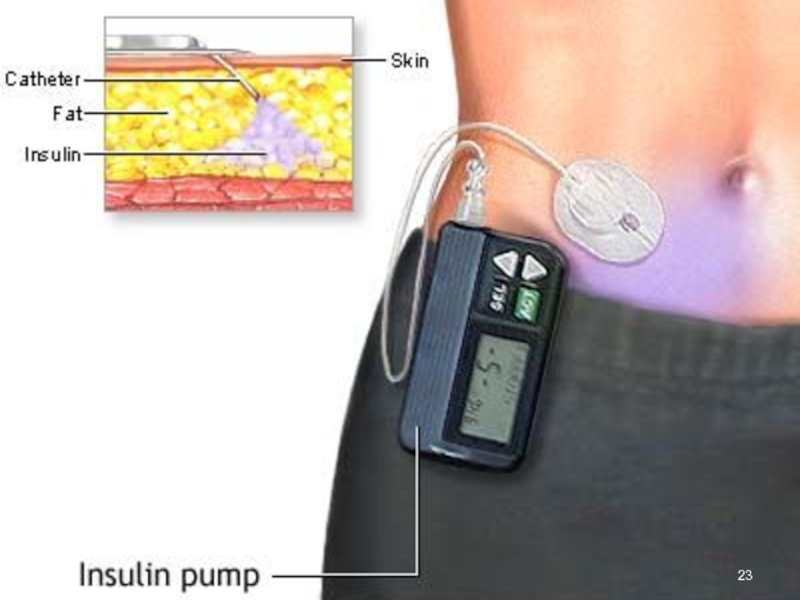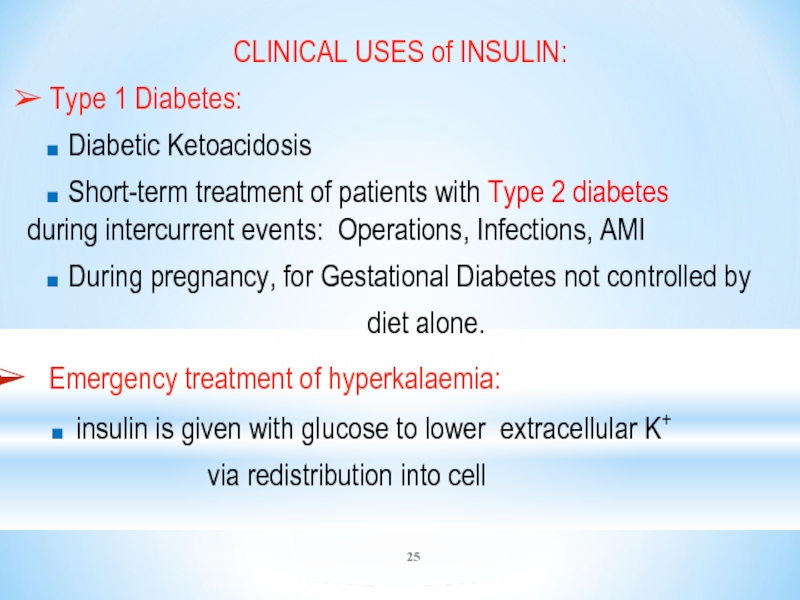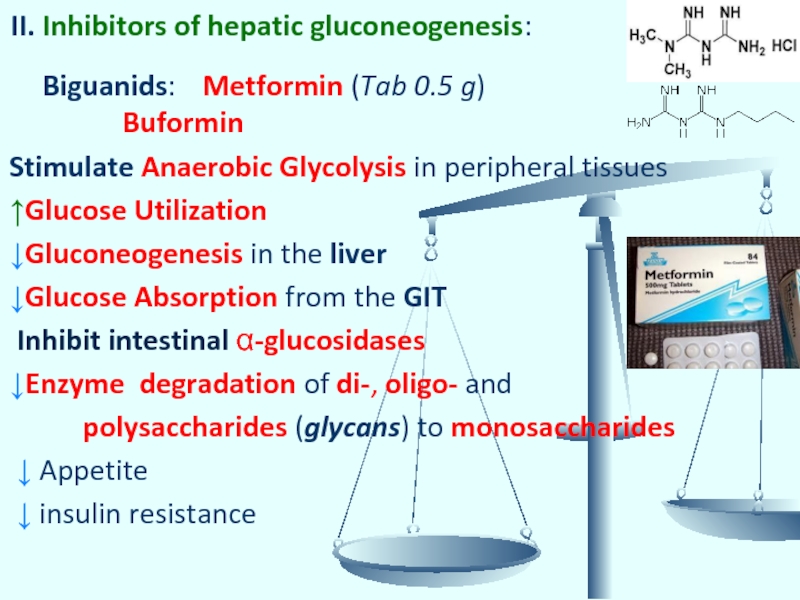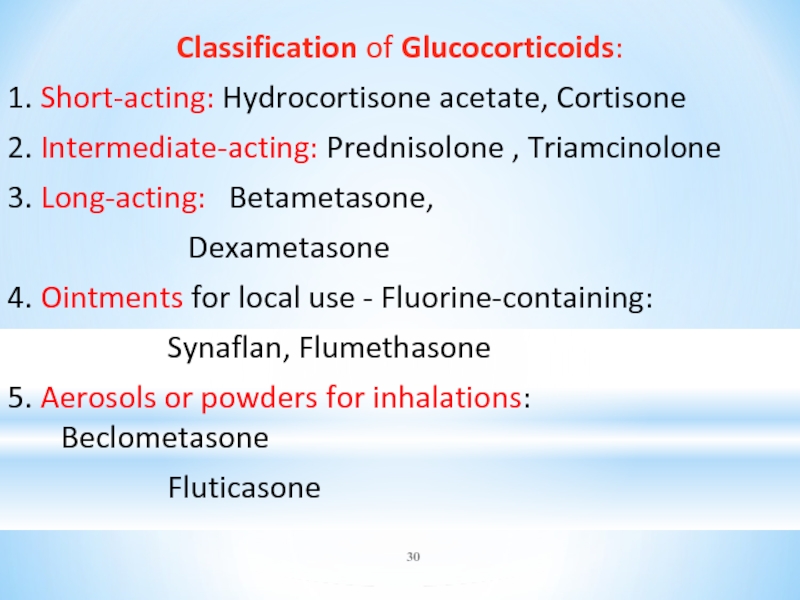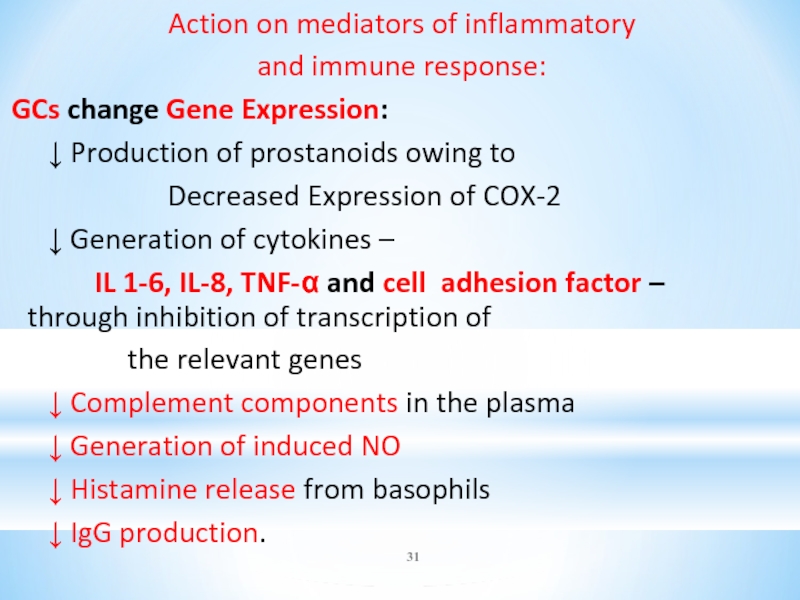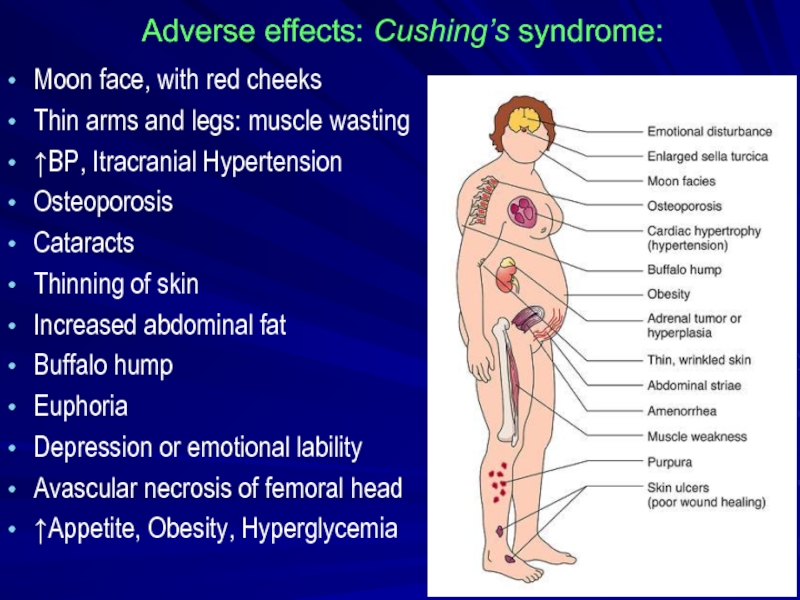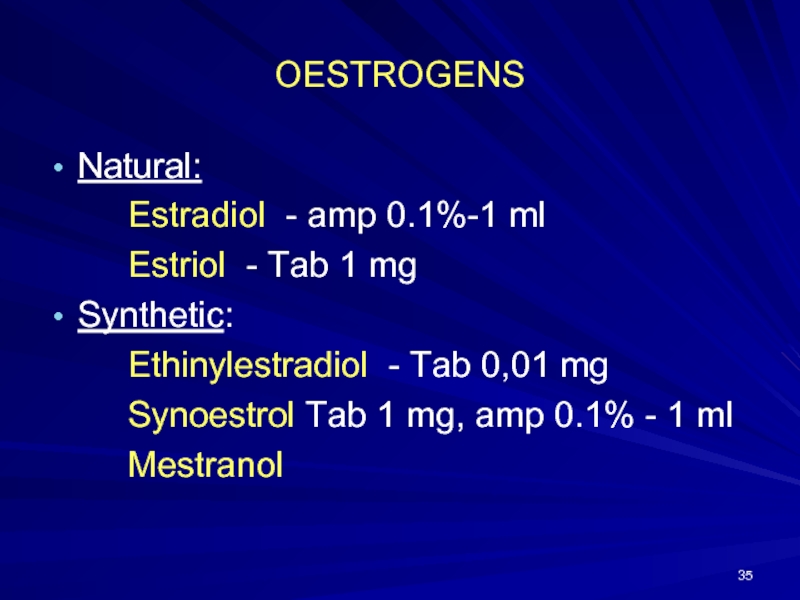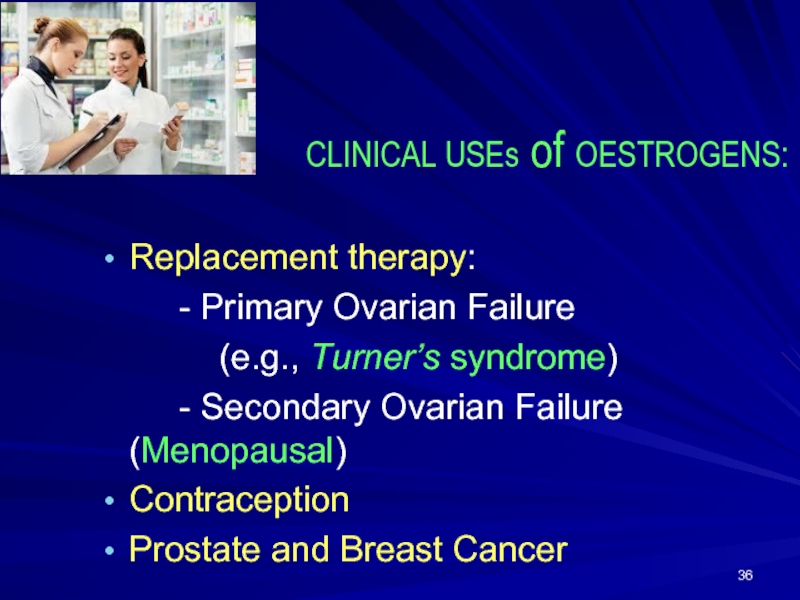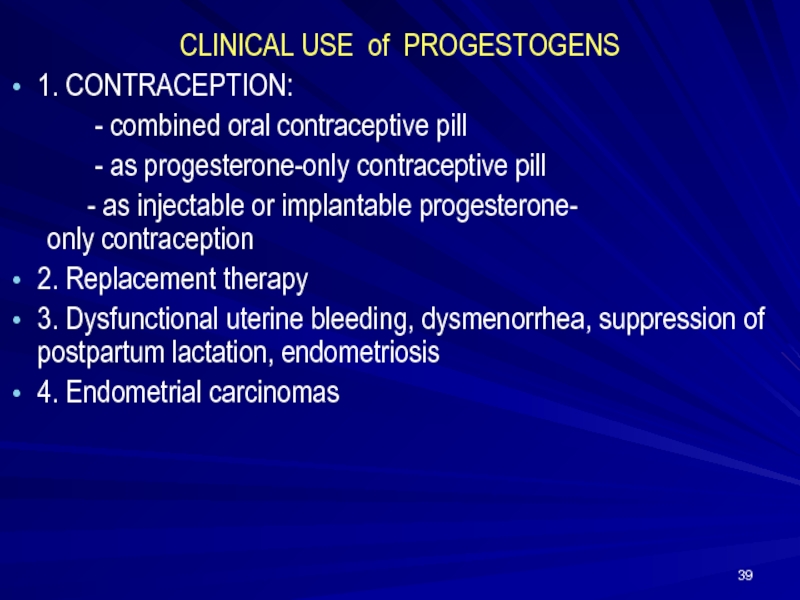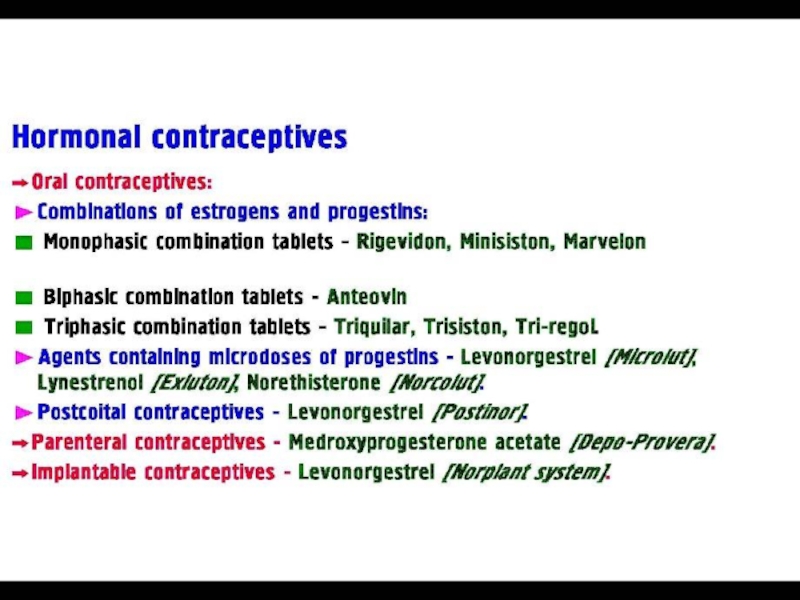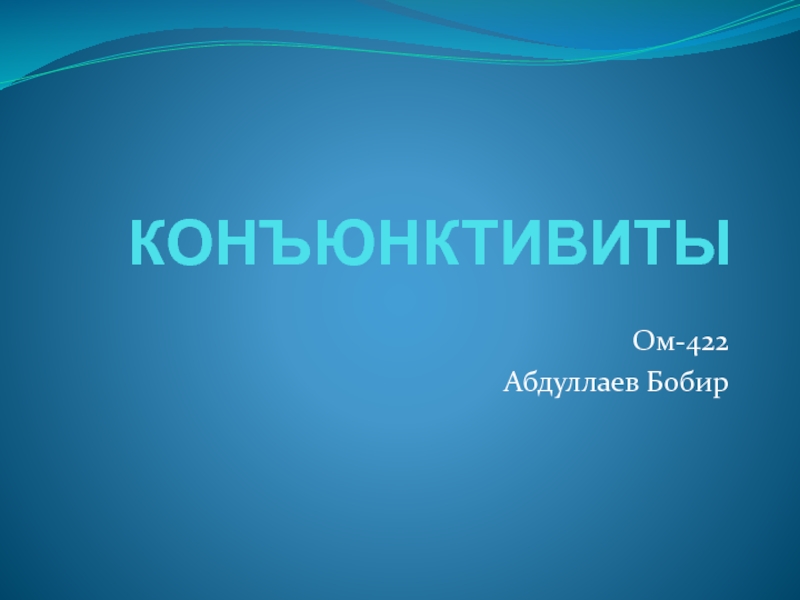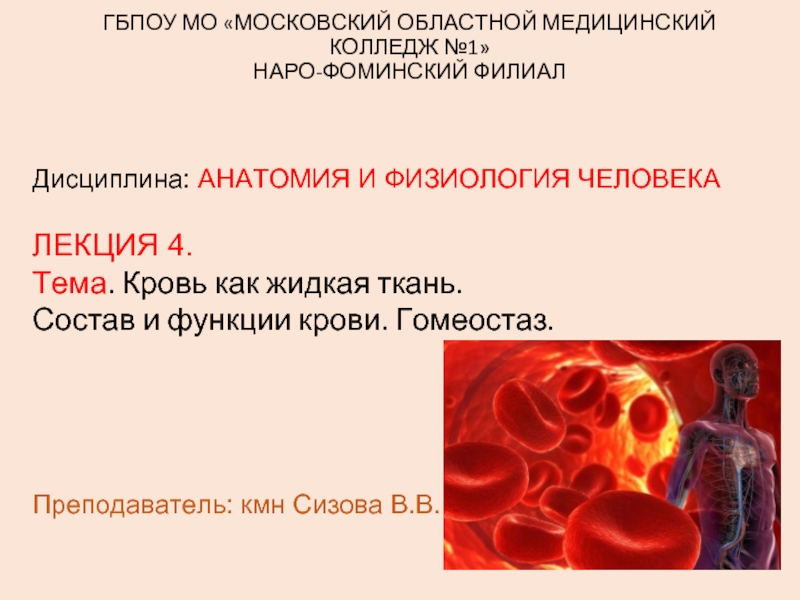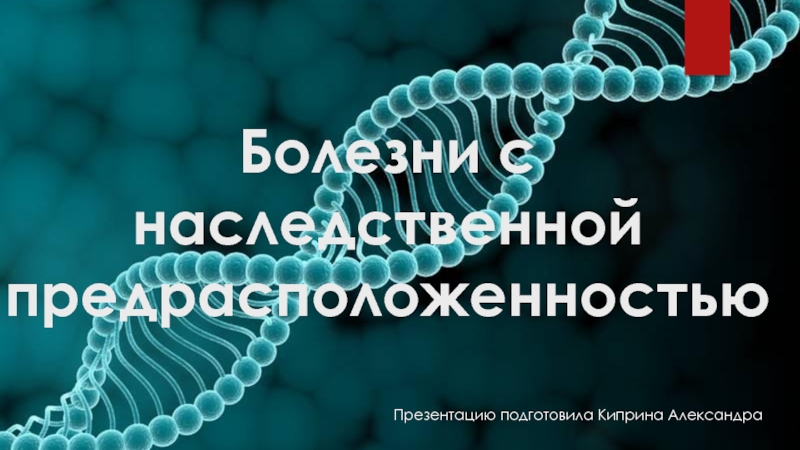- Главная
- Разное
- Дизайн
- Бизнес и предпринимательство
- Аналитика
- Образование
- Развлечения
- Красота и здоровье
- Финансы
- Государство
- Путешествия
- Спорт
- Недвижимость
- Армия
- Графика
- Культурология
- Еда и кулинария
- Лингвистика
- Английский язык
- Астрономия
- Алгебра
- Биология
- География
- Детские презентации
- Информатика
- История
- Литература
- Маркетинг
- Математика
- Медицина
- Менеджмент
- Музыка
- МХК
- Немецкий язык
- ОБЖ
- Обществознание
- Окружающий мир
- Педагогика
- Русский язык
- Технология
- Физика
- Философия
- Химия
- Шаблоны, картинки для презентаций
- Экология
- Экономика
- Юриспруденция
Drugs used in endocrine disorders презентация
Содержание
- 1. Drugs used in endocrine disorders
- 3. Mechanism of action Once hormones reach a
- 4. Second Messenger Systems Cyclic AMP is the
- 5. Ca2+ is the 2nd messenger for Gonadotropin-releasing
- 6. Some hormones activate cell membrane receptors and
- 7. Steroid Regulation of Protein Synthesis Steroid hormones
- 13. Thyroid Hormones: Thyroxine (Tetraiodothyronine,T4 -contains 4
- 14. Antithyroid drugs: are used to lower
- 15. INSULIN PREPARATIONS A. Rapid Acting Insulin -
- 16. C. Prolonged acting insulin: ∙
- 17. MECHANISM OF ACTION of INSULIN Insulin binds
- 20. Insulin is a fuel-storage hormone and
- 21. Actrapid (vial 10 ml : 40 and
- 22. Insulin Pens
- 24. Insulin Inhaling Device (Exubera)
- 25. CLINICAL USES of INSULIN: ➢ Type 1
- 26. Oral (Synthetic) Hypoglycemic Agents: I. Stimulators of
- 27. Repaglinide and Nateglinide are non-sulfonylureas meglitinides that
- 28. II. Inhibitors of hepatic gluconeogenesis: Biguanids:
- 29. III. Alfa-glucosidase inhibitor Acarbose (Glucobay) inhibits alpha-glucosidases
- 30. Classification of Glucocorticoids: 1. Short-acting: Hydrocortisone acetate,
- 31. Action on mediators of inflammatory and
- 32. Clinical uses of Glucocorticoids: 1. Replacement therapy
- 33. Adverse effects: Cushing’s syndrome: Moon face,
- 35. OESTROGENS Natural: Estradiol - amp
- 36. CLINICAL USEs of OESTROGENS: Replacement therapy:
- 37. ANTIOESTROGENS Clomiphene - Tab. 50 mg Tamoxifen
- 38. PROGESTOGENS 1. The naturally occurring hormone
- 39. CLINICAL USE of PROGESTOGENS 1. CONTRACEPTION:
- 42. Thank you for attention!
Слайд 3Mechanism of action
Once hormones reach a responsive cell, they bind with
receptors in the cell membrane ( protein hormones) or
inside the cell ( steroid and thyroid hormones).
Receptors may be increased (up-regulation) when there are
low levels of hormone or decreased (down-regulation) when
there are excessive amounts of hormone.
The hormone–receptor complex initiates intracellular reactions.
Many hormones act as a 1st messenger to the cell, and
the hormone–receptor complex activates a 2nd messenger.
The 2nd messenger then activates intracellular structures to produce characteristic cellular functions and products.
inside the cell ( steroid and thyroid hormones).
Receptors may be increased (up-regulation) when there are
low levels of hormone or decreased (down-regulation) when
there are excessive amounts of hormone.
The hormone–receptor complex initiates intracellular reactions.
Many hormones act as a 1st messenger to the cell, and
the hormone–receptor complex activates a 2nd messenger.
The 2nd messenger then activates intracellular structures to produce characteristic cellular functions and products.
Слайд 4Second Messenger Systems
Cyclic AMP is the 2nd messenger for many hormones,
including Corticotropin, Glucagon, Thyroid stimulating hormone,
Follicle stimulating hormone, Luteinizing hormone,
Parathyroid hormone and Antidiuretic hormone.
It is formed by the action of the enzyme adenyl cyclase on ATP. Once formed, cAMP activates reactions that alter cell function.
The amount of intracellular cAMP is increased by hormones that
activate adenyl cyclase:
the Pituitary hormones,
Calcitonin,
Glucagon,
Parathyroid hormone
and decreased by hormones that inactivate adenyl cyclase: Somatostatin
Follicle stimulating hormone, Luteinizing hormone,
Parathyroid hormone and Antidiuretic hormone.
It is formed by the action of the enzyme adenyl cyclase on ATP. Once formed, cAMP activates reactions that alter cell function.
The amount of intracellular cAMP is increased by hormones that
activate adenyl cyclase:
the Pituitary hormones,
Calcitonin,
Glucagon,
Parathyroid hormone
and decreased by hormones that inactivate adenyl cyclase: Somatostatin
Слайд 5Ca2+ is the 2nd messenger for Gonadotropin-releasing hormone. This hormone binds
to receptors to increase intracellular Ca2+.
The Ca2+ binds with an intracellular protein Calmodulin.
The Ca2+ – Calmodulin complex activates Protein kinases, which: Regulate contractile structures of the cell,
Cell membrane permeability, and
Intracellular enzyme activity.
Specific effects include:
Contraction of smooth muscle,
Changes in the secretions etc.
The Ca2+ binds with an intracellular protein Calmodulin.
The Ca2+ – Calmodulin complex activates Protein kinases, which: Regulate contractile structures of the cell,
Cell membrane permeability, and
Intracellular enzyme activity.
Specific effects include:
Contraction of smooth muscle,
Changes in the secretions etc.
Слайд 6Some hormones activate cell membrane receptors and transform them into phospholipase
C, an enzyme that causes some of
the phospholipids in cell membranes to split into smaller molecules:
inositol triphosphate and diacylglycerol which act
as 2nd messengers to intracellular structures.
Inositol triphosphate mobilizes intracellular Ca2+ ions which fulfil their functions as 2nd messengers.
Diacylglycerol activates an enzyme, protein kinase C that is
important in cell reproduction.
The lipid component of diacylglycerol is arachidonic acid -
the precursor for PGs, leukotrienes, and other local hormones
the phospholipids in cell membranes to split into smaller molecules:
inositol triphosphate and diacylglycerol which act
as 2nd messengers to intracellular structures.
Inositol triphosphate mobilizes intracellular Ca2+ ions which fulfil their functions as 2nd messengers.
Diacylglycerol activates an enzyme, protein kinase C that is
important in cell reproduction.
The lipid component of diacylglycerol is arachidonic acid -
the precursor for PGs, leukotrienes, and other local hormones
Слайд 7Steroid Regulation of Protein Synthesis
Steroid hormones are lipid soluble and cross
cell membranes easily.
Once inside the cell, the hormone molecules bind with specific receptor proteins.
The hormone–receptor complex enters the nucleus of the cell where it activates Gene Expression –
nucleic acids (DNA and RNA) and
the Genetic Code to synthesize
new proteins.
Once inside the cell, the hormone molecules bind with specific receptor proteins.
The hormone–receptor complex enters the nucleus of the cell where it activates Gene Expression –
nucleic acids (DNA and RNA) and
the Genetic Code to synthesize
new proteins.
Слайд 13Thyroid Hormones:
Thyroxine (Tetraiodothyronine,T4 -contains 4 atoms of iodine)
Triiodothyronine (T3 -
contains 3 atoms of iodine) is > potent and
has a more rapid onset but shorter duration of action
Calcitonin (a plasma Ca2+ lowering hormone).
L-Thyroxin (tab. 0.05 mg and 0.1 mg) is the drug of choice and the standard replacement therapy for Hypothyroidism,
Endemic Goiter (a manifestation of iodine deficiency).
Triiodothyronine (tab. 0.02 mg and 0.05 mg) is the treatment of choice for myxoedema coma, when its more rapid
action is required for emergency treatment.
Toxicity is related to thyroxine levels and manifests itself as
nervousness, heart palpitations and tachycardia,
intolerance to heat and unexplained weight loss.
has a more rapid onset but shorter duration of action
Calcitonin (a plasma Ca2+ lowering hormone).
L-Thyroxin (tab. 0.05 mg and 0.1 mg) is the drug of choice and the standard replacement therapy for Hypothyroidism,
Endemic Goiter (a manifestation of iodine deficiency).
Triiodothyronine (tab. 0.02 mg and 0.05 mg) is the treatment of choice for myxoedema coma, when its more rapid
action is required for emergency treatment.
Toxicity is related to thyroxine levels and manifests itself as
nervousness, heart palpitations and tachycardia,
intolerance to heat and unexplained weight loss.
Слайд 14Antithyroid drugs:
are used to lower the functional capacity of the
hyperactive thyroid gland and have the following directions of action:
1. Inhibit thyroid-stimulating hormone secretion
by anterior pituitary:
Iodine
Diiodthyrosine
2. Inhibit thyroid hormones synthesis in the thyroid gland:
Mercazolyl (Tab. 0.005 g)
Propylthiouracil
3. Inhibit iodine trapping by the thyroid gland:
Potassium perchlorate
4. Destroy thyroid tissue:
Radioactive iodine
1. Inhibit thyroid-stimulating hormone secretion
by anterior pituitary:
Iodine
Diiodthyrosine
2. Inhibit thyroid hormones synthesis in the thyroid gland:
Mercazolyl (Tab. 0.005 g)
Propylthiouracil
3. Inhibit iodine trapping by the thyroid gland:
Potassium perchlorate
4. Destroy thyroid tissue:
Radioactive iodine
Слайд 15INSULIN PREPARATIONS
A. Rapid Acting Insulin - max effect per 1-4 hours
short duration of action 4-8 hours
∙ Regular Insulin - vial 5 and 10 ml – 40 U/ml
∙ Insulin Lispro
∙ Actrapid - vial 10 ml - 40 and 100 IU/ml SC or IV
B. Intermediate Acting Insulin - max effect per 6-12 hours
Intermediate duration of action 18- 24 hours
∙ Semilente Insulin suspension
∙ Lente Insulin: a mixture of 30% Semilente Insulin and
70% Ultralente Insulin
Слайд 16C. Prolonged acting insulin:
∙ Ultralente Insulin
max effect per
12-18 hours
prolong duration of action 24-40 hours
prolong duration of action 24-40 hours
Glucose
Слайд 17MECHANISM OF ACTION of INSULIN
Insulin binds to receptor on the surface
of its target cells.
The receptor is a transmembrane glycoprotein complex consisting of two α- and two β-subunits.
The α-subunits are entirely extracellular and each carries
an insulin-binding site,
the β-subunits are transmembrane proteins with
tyrosine kinase activity.
This activity is suppressed by the α-subunits, but
insulin binding causes a conformational change that activates
the tyrosine kinase activity of the β-subunits, which act
on each other and on other target proteins.
ATP levels rise and block K+ channels (KATP), leading to membrane depolarization and an influx of Ca2+, which causes
pulsatile insulin exocytosis.
The receptor is a transmembrane glycoprotein complex consisting of two α- and two β-subunits.
The α-subunits are entirely extracellular and each carries
an insulin-binding site,
the β-subunits are transmembrane proteins with
tyrosine kinase activity.
This activity is suppressed by the α-subunits, but
insulin binding causes a conformational change that activates
the tyrosine kinase activity of the β-subunits, which act
on each other and on other target proteins.
ATP levels rise and block K+ channels (KATP), leading to membrane depolarization and an influx of Ca2+, which causes
pulsatile insulin exocytosis.
Слайд 20Insulin is a fuel-storage hormone and
affects cell growth and differentiation.
Insulin ↓Blood Glucose by:
↑Glucose uptake into muscle and fat via
a transporter Glut-4
↑Glycogen synthesis
↓Glycogen breakdown
↓Gluconeogenesis
Adrenaline ↑Blood Glucose by:
∙ Inhibiting Insulin Release (via α2-Receptors)
∙ Promoting Glycogenolysis (via β2-Receptors in Striated Muscle and liver)
Somatostatin inhibits Insulin Release.
Слайд 21Actrapid (vial 10 ml : 40 and 100 IU/ml for SC
or IV) - is a fast acting human insulin produced in Saccharomyces cerevisiae
by recombinant DNA technology. It may be used
in combination with intermediate or long-acting insulin.
It is administered SC by injection in the abdominal wall, the thigh,
the gluteal region or the deltoid region.
Injection into a lifted skin fold minimizes the risk of unintended IM injection. The needle should be kept under the skin
for at least 6 sec to make sure the entire dose is injected.
Injection sites should always be rotated within the same region in order to reduce the risk of lipodystrophy.
SC injection into the abdominal wall ensures a faster absorption than other injection sites. The duration of action will vary according to the dose, injection site, blood flow, temperature and level of physical activity.
by recombinant DNA technology. It may be used
in combination with intermediate or long-acting insulin.
It is administered SC by injection in the abdominal wall, the thigh,
the gluteal region or the deltoid region.
Injection into a lifted skin fold minimizes the risk of unintended IM injection. The needle should be kept under the skin
for at least 6 sec to make sure the entire dose is injected.
Injection sites should always be rotated within the same region in order to reduce the risk of lipodystrophy.
SC injection into the abdominal wall ensures a faster absorption than other injection sites. The duration of action will vary according to the dose, injection site, blood flow, temperature and level of physical activity.
Слайд 25CLINICAL USES of INSULIN:
➢ Type 1 Diabetes:
■ Diabetic Ketoacidosis
■ Short-term treatment
of patients with Type 2 diabetes during intercurrent events: Operations, Infections, AMI
■ During pregnancy, for Gestational Diabetes not controlled by
diet alone.
Emergency treatment of hyperkalaemia:
■ insulin is given with glucose to lower extracellular K+
via redistribution into cell
■ During pregnancy, for Gestational Diabetes not controlled by
diet alone.
Emergency treatment of hyperkalaemia:
■ insulin is given with glucose to lower extracellular K+
via redistribution into cell
Слайд 26Oral (Synthetic) Hypoglycemic Agents:
I. Stimulators of insulin release by beta cells:
1. Sulfonylurea derivatives:
I. Generation – moderate duration of action (8-24 hours):
Butamide (Tolbutamide)
II Generation – Long duration of action (24-60 hours):
Chlorpropamide (tab. 0.1 and 0.25 g)
Glibenclamide (tab.5 mg)
Glipizide (tab. 5 mg)
2. Meglitinides:
Repaglinide (tab. 1 mg)
Nateglinide (tab. 120 mg)
Слайд 27Repaglinide and Nateglinide are non-sulfonylureas meglitinides that lower blood sugar by
stimulating pancreatic secretion of insulin.
■ can be used as monotherapy with diet and exercise or
in combination with Metformin.
■ well absorbed from the GIT;
peak plasma level occurs within 1 hour.
■ have a plasma half-life of 1–1.5 hours and
are highly bound (>98%) to plasma proteins.
Repaglinide (NovoNorm) is metabolized and
removed from the bloodstream within 3–4 hours after a dose,
Nateglinide within ~6 hours. This decreases the workload of
pancreatic β cells (i.e., decreases duration of β-cell stimulation),
allows plasma insulin levels to return to normal before
the next meal, and
decreases risks of hypoglycemic episodes.
■ can be used as monotherapy with diet and exercise or
in combination with Metformin.
■ well absorbed from the GIT;
peak plasma level occurs within 1 hour.
■ have a plasma half-life of 1–1.5 hours and
are highly bound (>98%) to plasma proteins.
Repaglinide (NovoNorm) is metabolized and
removed from the bloodstream within 3–4 hours after a dose,
Nateglinide within ~6 hours. This decreases the workload of
pancreatic β cells (i.e., decreases duration of β-cell stimulation),
allows plasma insulin levels to return to normal before
the next meal, and
decreases risks of hypoglycemic episodes.
Слайд 28 II. Inhibitors of hepatic gluconeogenesis:
Biguanids: Metformin (Tab 0.5 g)
Buformin
Stimulate
Anaerobic Glycolysis in peripheral tissues
↑Glucose Utilization
↓Gluconeogenesis in the liver
↓Glucose Absorption from the GIT
Inhibit intestinal α-glucosidases
↓Enzyme degradation of di-, oligo- and
polysaccharides (glycans) to monosaccharides
↓ Appetite
↓ insulin resistance
↑Glucose Utilization
↓Gluconeogenesis in the liver
↓Glucose Absorption from the GIT
Inhibit intestinal α-glucosidases
↓Enzyme degradation of di-, oligo- and
polysaccharides (glycans) to monosaccharides
↓ Appetite
↓ insulin resistance
Слайд 29III. Alfa-glucosidase inhibitor Acarbose (Glucobay)
inhibits alpha-glucosidases in the brush border
of
the small intestines and
pancreatic alpha-amylase.
Pancreatic alfa-amilase hydrolyzes complex starches to
oligosaccharides in the lumen of the small intestine.
The membrane-bound intestinal α-glucosidases hydrolyze
oligosaccharides, trisaccharides, and disaccharides to glucose
and other monosaccharides in the small intestine.
■ ↓ the rate of digestion of complex carbohydrates.
■ The carbohydrates are not broken down into glucose molecules.
■ The long-term effect is a reduction in glycated Hb (HbA1c).
Side effects: diarrhea, flatulation.
pancreatic alpha-amylase.
Pancreatic alfa-amilase hydrolyzes complex starches to
oligosaccharides in the lumen of the small intestine.
The membrane-bound intestinal α-glucosidases hydrolyze
oligosaccharides, trisaccharides, and disaccharides to glucose
and other monosaccharides in the small intestine.
■ ↓ the rate of digestion of complex carbohydrates.
■ The carbohydrates are not broken down into glucose molecules.
■ The long-term effect is a reduction in glycated Hb (HbA1c).
Side effects: diarrhea, flatulation.
Слайд 30Classification of Glucocorticoids:
1. Short-acting: Hydrocortisone acetate, Cortisone
2. Intermediate-acting: Prednisolone , Triamcinolone
3. Long-acting: Betametasone,
Dexametasone
4. Ointments for local use - Fluorine-containing:
Synaflan, Flumethasone
5. Aerosols or powders for inhalations: Beclometasone
Fluticasone
Слайд 31Action on mediators of inflammatory
and immune response:
GCs change Gene Expression:
↓ Production of prostanoids owing to
Decreased Expression of COX-2
↓ Generation of cytokines –
IL 1-6, IL-8, TNF-α and cell adhesion factor – through inhibition of transcription of
the relevant genes
↓ Complement components in the plasma
↓ Generation of induced NO
↓ Histamine release from basophils
↓ IgG production.
Слайд 32Clinical uses of Glucocorticoids:
1. Replacement therapy for patients with adrenal failure
-
Addison’s disease
2. Anti-Inflammatory Immunosuppressive Therapy:
■ Asthma
■ Inflammatory conditions of skin, eye, ear or nose:
Eczema, Allergic Conjunctivitis or Rhinitis – topically
■ Hypersensitivity States: Severe Allergic Reactions – IV
3. In neoplastic diseases:
■ In combination with Cytotoxic Drugs as a component of
Antiemetic Treatment in the treatment of Specific Malignancies
Addison’s disease
2. Anti-Inflammatory Immunosuppressive Therapy:
■ Asthma
■ Inflammatory conditions of skin, eye, ear or nose:
Eczema, Allergic Conjunctivitis or Rhinitis – topically
■ Hypersensitivity States: Severe Allergic Reactions – IV
3. In neoplastic diseases:
■ In combination with Cytotoxic Drugs as a component of
Antiemetic Treatment in the treatment of Specific Malignancies
Слайд 33Adverse effects: Cushing’s syndrome:
Moon face, with red cheeks
Thin arms and
legs: muscle wasting
↑BP, Itracranial Hypertension
Osteoporosis
Cataracts
Thinning of skin
Increased abdominal fat
Buffalo hump
Euphoria
Depression or emotional lability
Avascular necrosis of femoral head
↑Appetite, Obesity, Hyperglycemia
↑BP, Itracranial Hypertension
Osteoporosis
Cataracts
Thinning of skin
Increased abdominal fat
Buffalo hump
Euphoria
Depression or emotional lability
Avascular necrosis of femoral head
↑Appetite, Obesity, Hyperglycemia
Слайд 35OESTROGENS
Natural:
Estradiol - amp 0.1%-1 ml
Estriol - Tab 1 mg
Synthetic:
Ethinylestradiol - Tab 0,01 mg
Synoestrol Tab 1 mg, amp 0.1% - 1 ml
Mestranol
Слайд 36CLINICAL USEs of OESTROGENS:
Replacement therapy:
- Primary Ovarian Failure
(e.g., Turner’s syndrome)
-
Secondary Ovarian Failure (Menopausal)
Contraception
Prostate and Breast Cancer
Contraception
Prostate and Breast Cancer
Слайд 37ANTIOESTROGENS
Clomiphene - Tab. 50 mg
Tamoxifen - Tab. 20 mg
Clomiphene:
Interfering with the
Negative Feedback of oestrogens on the hypothalamus and pituitary
=> ↑Secretion of Gn-RH
↑Secretion of Gonadotropins
=> a Stimulation of Ovulation
Clinical use:
Infertility with Anovulatory Cycles
Breast Tumors
=> ↑Secretion of Gn-RH
↑Secretion of Gonadotropins
=> a Stimulation of Ovulation
Clinical use:
Infertility with Anovulatory Cycles
Breast Tumors
Слайд 38PROGESTOGENS
1. The naturally occurring hormone and its derivatives:
Progesteron amp. 1%
- 1 ml of oil solution
Oxyprogesterone Caproate amp. 25% - 1 ml
Pregnin Tab. 0.01
2. Testosterone derivatives:
Norethisterone Tab. 5 mg
Norgestrel
Desogestrel
Gestodene
Oxyprogesterone Caproate amp. 25% - 1 ml
Pregnin Tab. 0.01
2. Testosterone derivatives:
Norethisterone Tab. 5 mg
Norgestrel
Desogestrel
Gestodene
Слайд 39CLINICAL USE of PROGESTOGENS
1. CONTRACEPTION:
- combined oral contraceptive pill
- as progesterone-only contraceptive pill
- as injectable or implantable progesterone- only contraception
2. Replacement therapy
3. Dysfunctional uterine bleeding, dysmenorrhea, suppression of postpartum lactation, endometriosis
4. Endometrial carcinomas
- as injectable or implantable progesterone- only contraception
2. Replacement therapy
3. Dysfunctional uterine bleeding, dysmenorrhea, suppression of postpartum lactation, endometriosis
4. Endometrial carcinomas
